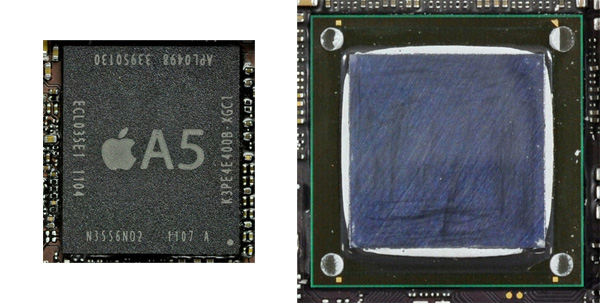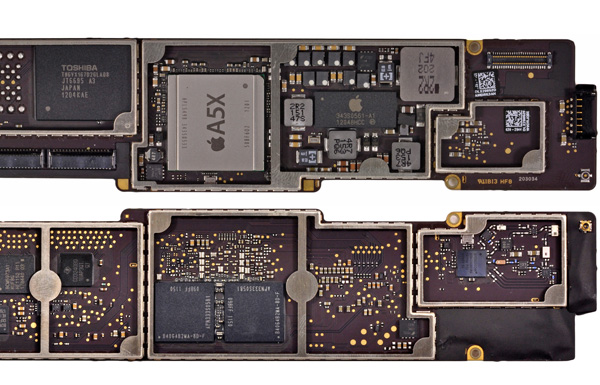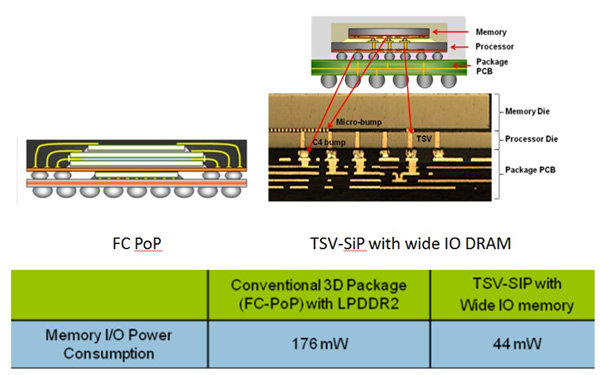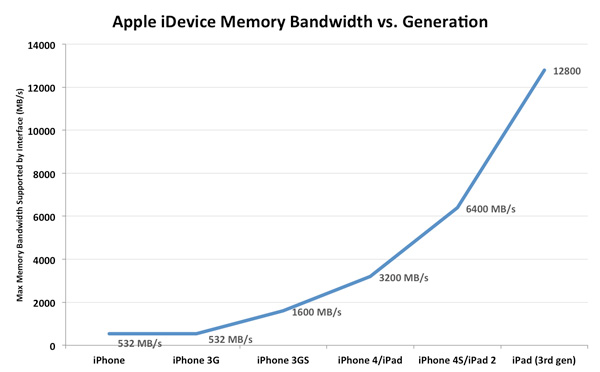The Apple iPad Review (2012)
by Vivek Gowri & Anand Lal Shimpi on March 28, 2012 3:14 PM ESTA Word on Packaging
Unlike the first two iPads, the 3rd generation iPad abandons the high density flip-chip PoP SoC/DRAM stack and uses a discrete, flip-chip BGA package for the SoC and two discrete BGA packages for the DRAMs.
If you think of SoC silicon as a stack, the lowest layer is where you'll find the actual transistor logic, while the layers of metal above it connect everything together. In the old days, the silicon stack would sit just as I've described it—logic at the bottom, metal layers on top. Pads around the perimeter of the top of the silicon would connect to very thin wires, that would then route to the package substrate and eventually out to balls or pins on the underside of the package. These wire bonded packages, as they were called, had lower limits of how many pins you could have connecting to your chip.
There are also cooling concerns. In a traditional wire bonded package, your cooling solution ultimately rests on a piece of your packaging substrate. The actual silicon itself isn't exposed.
As its name implies, a flip-chip package is literally the inverse of this. Instead of the metal layers being at the top of the stack, before packaging the silicon is inverted and the metal layers are at the bottom of the stack. Solder bumps at the top of the silicon stack (now flipped and at the bottom) connect the topmost metal layer to the package itself. Since we're dealing with solder bumps on the silicon itself rather than wires routed to the edge of the silicon, there's much more surface area for signals to get in/out of the silicon.
Since the chip is flipped, the active logic is now exposed in a flip-chip package and the hottest part of the silicon can be directly attached to a cooling solution.

An example of a PoP stack
To save on PCB real estate however, many SoC vendors would take a flip-chip SoC and stack DRAM on top of it in a package-on-package (PoP) configuration. Ultimately this re-introduces many of the problems from older packaging techniques—mainly it becomes difficult to have super wide memory interfaces as your ball-out for the PoP stack is limited to the area around your die, and cooling is a concern once more. For low power, low bandwidth mobile SoCs this hasn't really been a problem, which is why we see PoP stacks deployed all over the place.
Take a look at the A5, a traditional FC-BGA SoC with PoP DRAM vs. the A5X (this isn't to scale):

Images courtesy iFixit
The A5X in this case is a FC-BGA SoC but without any DRAM stacked on top of it. The A5X is instead covered in a thermally conductive paste and then with a metallic heatspreader to conduct heat away from the SoC and protect the silicon.
Given the size and complexity of the A5X SoC, it's no surprise that Apple didn't want to insulate the silicon with a stack of DRAM on top of it. In typical package-on-package stacks, you'd see solder bumps around the silicon, on the package itself, that a separate DRAM package would adhere to. Instead of building up a PoP stack here, Apple simply located its two 64-bit DRAM devices on the opposite side of the iPad's logic board and routed the four 32-bit LP-DDR2 memory channels through the PCB layers.

iPad (3rd gen) logic board back (top) and front (bottom), courtesy iFixit
If I'm seeing this correctly, it looks like the DRAM devices are shifted lower than the center point of the A5X. Routing high speed parallel interfaces isn't easy and getting the DRAM as close to the memory controller as possible makes a lot of sense. For years motherboard manufacturers and chipset vendors alike complained about the difficulties of routing a high-speed, 128-bit parallel DRAM interface on a (huge, by comparison) ATX motherboard. What Apple and its partners have achieved here is impressive when you consider that this type of interface only made it to PCs within the past decade.
Looking Forward: 12.8GB/s, the Magical Number
The DRAM speeds in the new iPad haven't changed. The -8D in the Elpida DRAM string tells us this memory is rated at the same 800MHz datarate as what's used in the iPhone 4S and iPad 2. With twice the number of channels to transfer data over however, the total available bandwidth (at least to the GPU) doubles. I brought back the graph I made for our iPhone 4S review to show just how things have improved:
The A5X's memory interface is capable of sending/receiving data at up to 12.8GB/s. While this is still no where near the 100GB/s+ we need for desktop quality graphics at Retina Display resolutions, it's absolutely insane for a mobile SoC. Bandwidth utilization is another story entirely—we have no idea how good Apple's memory controller is (it is designed in-house), but there's 4x the theoretical bandwidth available to the A5X as there is to NVIDIA's Tegra 3.
There's a ton of memory bandwidth here, but Apple got to this point by building a huge, very power hungry SoC. Too power hungry for use in a smartphone. As I mentioned at the start of this article, the SoC alone in the new iPad can consume more power than the entire iPhone 4S (e.g. A5X running Infinity Blade 2 vs. iPhone 4S loading a web page):
| Power Consumption Comparison | ||||
| Apple A5X (SoC + mem interface) | Apple iPhone 4S (entire device) | |||
| Estimated Power Consumption | 2.6W—Infinity Blade 2 | 1.6W—Web Page Loading | ||
There's no question that we need this much (and more) memory bandwidth, but the A5X's route to delivering it is too costly from a standpoint of power. There is a solution to this problem however: Wide IO DRAM.
Instead of using wires to connect DRAM to solder balls on a package that's then stacked on top of your SoC package, Wide IO DRAM uses through-silicon-vias (TSVs) to connect a DRAM die directly to the SoC die. It's an even more costly packaging technique, but the benefits are huge.

Just as we saw in our discussion of flip-chip vs. wire bonded packages, conventional PoP solutions have limits to how many IO pins you can have in the stack. If you can use the entire silicon surface for direct IO however, you can build some very wide interfaces. It also turns out that these through silicon interfaces are extremely power efficient.
The first Wide IO DRAM spec calls for a 512-bit, 200MHz SDR (single data rate) interface delivering an aggregate of 12.8GB/s of bandwidth. The bandwidth comes at much lower power consumption, while delivering all of the integration benefits of a traditional PoP stack. There are still cooling concerns, but for lower wattage chips they are less worrisome.
Intel originally predicted that by 2015 we'd see 3D die stacking using through-silicon-vias. Qualcomm's roadmaps project usage of TSVs by 2015 as well. The iPhone won't need this much bandwidth in its next generation thanks to a lower resolution display, but when the time comes, there will be a much lower power solution available thanks to Wide IO DRAM.
Oh and 2015 appears to be a very conservative estimate. I'm expecting to see the first Wide IO memory controllers implemented long before then...











234 Comments
View All Comments
zanon - Wednesday, March 28, 2012 - link
In the article:The higher resolution does make smaller fonts readable. For something like an SSH session, that really will mean significantly more stuff can be on a screen at once.
MobiusStrip - Thursday, March 29, 2012 - link
A more useful change would be abandoning the ridiculous glossy screens. It's sad that Apple takes its cues from the plastic schlock being peddled at Best Buy, and participates in this fraud of shoving glossy screens down customers' throats.repoman27 - Thursday, March 29, 2012 - link
The plastic schlock at Best Buy has a glossy plastic film applied to a cheap TN panel. Apple puts a piece of glass in front of their much more expensive IPS panels to protect them. The only way to make that glass (or the glass of the LCD panel itself) matte would be to apply an antiglare plastic film coating to the glass. These films have drawbacks (they block and scatter light making small details and text blurry.) The drawbacks become more exaggerated the farther the front surface of the glass is from the plane of the actual LCD.But you're right, it's probably Apple copying the design language of sub $500 laptops in order to somehow defraud the general public and force their customers to buy the products they actually produce.
And seeing as how this discussion is about the new iPad screen, I'd like to point out that you're complaining about the lack of an antiglare coating on a touchscreen device... Strong work.
Sabresiberian - Thursday, March 29, 2012 - link
How is it fraud? Apple isn't, like, saying their screens are anti-reflective and then giving you totally reflective glossy screens.Many people prefer a glossy screen and simply aren't bothered by background reflections.
;)
Henk Poley - Monday, April 2, 2012 - link
Yes, Apple really should use Schott Conturan/Amiran/Mirogard antireflective technology.btw, not-glossy does not mean matte. Air is not matte either. Glass can be see-through too ;)
Watwatwat - Monday, April 2, 2012 - link
Nope, steve gibson has tested even using screen protectors on the new ipad vs not, it seems to affect the resolution at that level, matte might not be a good idea at all for high density display.KoolAidMan1 - Thursday, March 29, 2012 - link
I wasn't initially blown away, but then after a day of using it every other display seemed bad in comparison. It is one of those things you didn't realize was needed until using it, now I want very high DPI in all of my monitors.menting - Wednesday, March 28, 2012 - link
Is it just me, or do Shadowgun and GTA screenshots look more detailed in Transformer Prime than in the iPad?menting - Wednesday, March 28, 2012 - link
nm..i just noticed that it's scaled up in new ipad, so it's definitely not as sharp.However, how can fps be fairly compared in this case then?
TheJian - Wednesday, March 28, 2012 - link
Basically because of the way Nvidia and Apple approach games so far, you can expect games on Tegra3 to just look better as they seem to aim for more graphics and fewer games (they spend money on fewer projects that produce better results), as opposed to apple who spreads the wealth but just ends up with more cannon fodder if you ask me :) You should get more variety on Apple I'd guess, but a better experience with fewer choices on Tegra3/Android. I like QUALITY over QUANTITY personally and hope Apple leans the way of Nvidia in the future. I would rather have 10 games that I'd play for weeks or months (if I'm playing on my hdtv through one of these I want better water, buildings etc) rather than games I fire up for less than 20 minutes as their just another angry birds variant and arguably useless on your TV.I want these devices to KILL the consoles next year and make MS/Nintendo etc give it up in 2015 or whenever the next revs should come. I hope they just realize we won't buy them anymore. DirectX11 on my phone/tablet and probably standard 25x14 resolutions by then (won't all be retina by 2015?) make a console purchase STUPID. This could be the merging of console/pc we need since phones/tablets rev yearly like pc's instead of 10yr console's stuck in stone stagnating gaming. Your phone as a portable console with xbox/ps3/pc gamepad support would be excellent. Pump it out to a monitor and keyboard/mouse setup and you have a notebook replacement too...LOL Now if they'd just put in a few extra cores by then that will disable if on their own screen but turn on when on a larger display like TV/Monitor and we have exactly what we want in both cases :)
Pipe dreams? Retina is here now, and gamepads sort of. Next stop cores that only turn on depending on display output :) Awesome battery on the road, and great power in the dock at home pushing your 27in monitor. :) The 28nm versions by xmas of everyone's chips should come close to console power or surpass them. Interesting times.